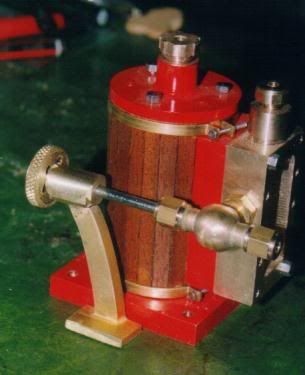Nick, thanks again. I've seen old "real" boilers and a couple of old engines that had wood on the outside. Dave (Steamer) sent me a couple of pictures of (full size) brass lagged machines, which really did look nice. I don't know if there is wood under the brass lagging, or some type of regular insulation, like asbestos, and like that.
Joe, I'm with you on brass "anything". Thanks for your kind comments!
Today, just a few shots of the finish work. Although it's not real machine work, it needs
to be done, and someone may get something out of it.
First, the engine is disassembled to it's basic construction units so I can get to a few things.
The base needs a lot of finish work. For this piece, I chose what was probably the roughest
piece of aluminum flat that ever came out of a finish mill. It's what I had on hand. It may not
be visible in the picture, but it has grooves all down the long dimension, and the piece needs to
be filed flat. Also, a few rough spots on other pieces that need a little touch up.
Once that was done, the base was masked on the top and the rest of it painted the same
color as the sub-base.
Some gaskets need to be made for the heads, and for each piece of the steam chest assembly.
For the gaskets, brown paper sacks work well. If you need thicker gaskets, use large grocery
bags. For thinner gaskets, like I want, a small sack is better. I usually use the type of sack that
is flat, like what stationary comes in. They have a shiny-ish appearance, but couldn't find any last
time I was in town. That worked out well, though. The sack in the picture has a regular finish,
(not shiny), and it soaked up oil very well, which is what I want.
If you use this method for gaskets, best to avoid the white kind of sack that comes from greeting
card shops. They are very smooth, and some seem to repel oil to some extent. They may have a
little wax in them, or something similar.
Another note; I don't know if this kind of gasket will work well for things like cylinder heads on IC
engines, although I've used them for crankcase seals on that type of engine.
After marking out the general dimensions on the paper, one of the heads is coated with oil.
Once the oil soaks into the paper for a minute, it becomes transparent, and the locations for
the holes can be plainly seen.
I just poke the hole centers with a darning needle to mark them.
Then use one of these things to punch the holes out, using the pin holes to locate the punch.
The round bit that the punch cuts usually stays in the hole, and must be plucked out with a pin
or the edge of a razor blade. Hanging chad..
And there's a finished gasket. It's square, because that's the shape of the cylinder.
Next, a little packing for the glands. I used teflon tape for this, but have used small diameter
soft cotton string, too. For using teflon tape, peel off a few inches, and roll it between your
fingers to make like a rope. Then wrap it around the piston or valve shaft, and use the gland
to push it down into the recess where it will reside. It can't be pushed in too hard, or it will
start to squeeze on the shaft that runs in the packing. It needs oil, too, whether using teflon
tape or string.
There it is pushed gently into the hole.
Once it has been pushed into the hole, it holds it's shape pretty well.
That's it for today. Just have to finish re-assembling, and then, make the display base. The
base will probably take me days. It's made of wood. Eh...
Thanks again for looking in!
Dean














